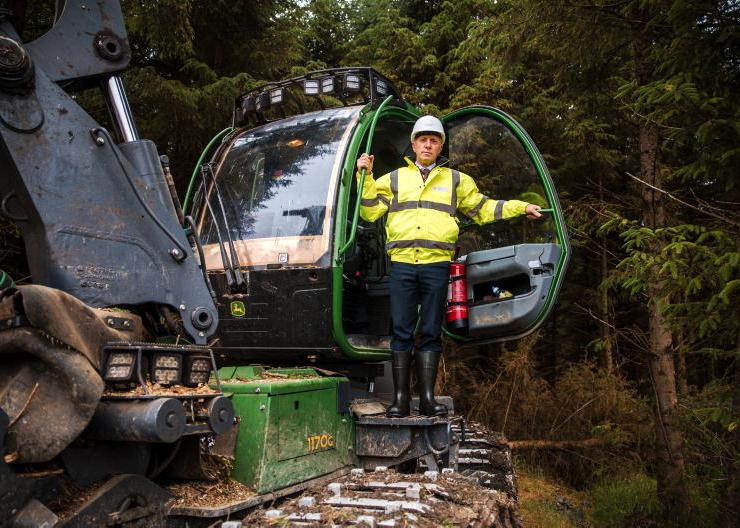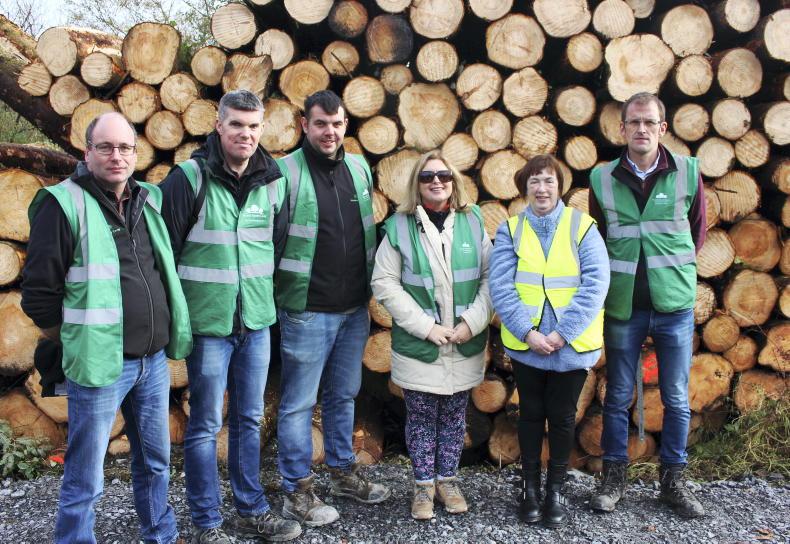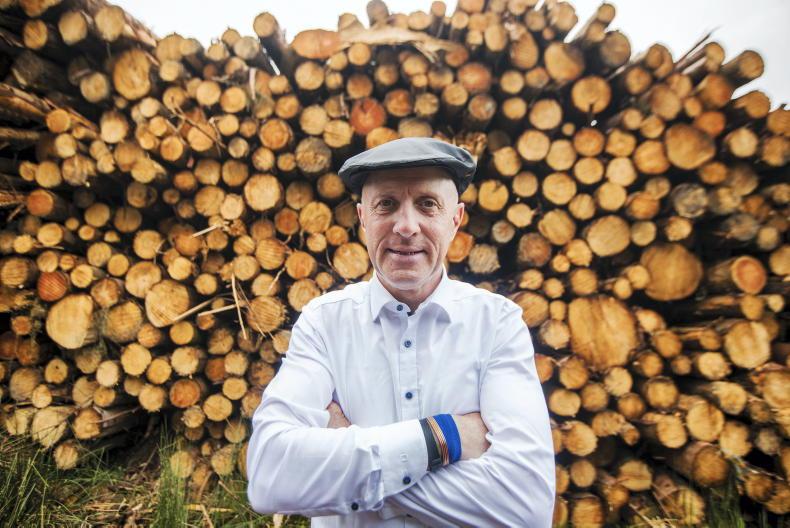In 2015, the total volume of roundwood input purchases was 715,000m3, which amounted to 26% of total log purchases in Ireland according to recent CSO data. Last year, 1.168m m3 of purchases were sourced from private forests or 36% of total timber purchases (Figure 1).
Private timber production is forecast to increase further due to large-scale private planting from 1989 to 2006.
Coillte’s production has plateaued, largely because the company withdrew from afforestation during the early 1990s, concentrating on reforesting clearfelled areas.
However, the company did increase log supply from 2015 to 2019 – 2.063m m3 to 2.445m m3 – but reduced output to 2.044m m3 last year.
CSO statistics are provided in m3 of wood input purchases for the private sector and “publicly owned forests” which in effect are Coillte forests.
Other publicly owned forests and woodlands managed by the National Parks and Wildlife Service, and local authorities do not engage in commercial timber harvesting of scale.
Log supply increased from 3.066 in 2020 to 3.212m m3 last year, while total roundwood and non-roundwood purchases increased from 3,225m t to 3,316m t (Table 1).
“Large sawlog accounted for the highest proportion of roundwood purchase volume at approximately 42% in 2021, followed by small sawlog (26%) and pulpwood (25%),” said Niamh Shanahan, statistician at the environment and climate division of the CSO.
“Approximately 5% of roundwood purchases were for use as biomass,” she added. “In 2021, purchases of non-roundwood products such as brash and tree stumps, woodchip and sawdust totalled 487,000t.”
Other interesting data to emerge from the CSO data is the product breakdown since 2015 (Table 1).
The percentage of large sawlog has increased from 32% to 35% of total purchases, while small sawlog has remained at 22% to 23%.
Pulpwood, as a total of overall roundwood, has fallen from 28% to 22% of total production, which would indicate that sawmills are maximising the sawlog content.
Woodchip has increased from 7% (192,000t) to 11% (361,000t) while roundwood for use as biomass at 137,000t to 138,000t has fallen significantly as a percentage of overall volume (7% to 4%).
Certification
Sawmills wishing to retain chain of custody certification have log intake capped at 30% of uncertified timber.
The CSO data shows that log intake from private forests is now at 36% of total volume, which means that some of this volume is now going to mills without certification as most private timber growers have yet to achieve certification.
Forest owners without certification may have to sell to uncertified mills in future. This will result in price reduction for uncertified forest owners but increases for growers with certification.
Achieving felling licences on time and the need for private forest owners to achieve certification are the two major challenges facing timber growers and the Department as the timber supply from private growers is forecast to increase to 3.5m m3 within eight years.
NEFG first forestry group to achieve forest certification
The North East Forestry Group (NEFG) has retained forest certification, which member John Sherlock said is a landmark achievement in Irish private forestry.
Certification is independent acknowledgement that members’ forests and woodlands are managed, according to the principles of sustainable forest management (SFM).
Members of the NEFG have been sustainably managing their forests for decades but independent certification is required as proof of SFM. While certification is essentially an environmental exercise, it also has economic benefits and costs. John Sherlock, who has been at the forefront of the NEFG certification drive, acknowledged Department of Agriculture, Food and the Marine funding, but believes “greater support is required to achieve national certification which is the eventual goal”.
The NEFG shared its experience and knowledge of certification during their recent Knowledge Transfer Group (KTG) events.
Forester Sarah Standish, who is the NEFG group facilitator, led each course module while Donal Whelan and Mechteld Schuller worked with the group on certification.
“The KTG programme proved to be a fantastic opportunity for private forest owners who are thinking about certifying their forest,” said NEFG chair Derek McCabe. “It is an opportunity for private owners to take control of their investment as knowledge is power and knowledge in a group setting is even more powerful,” he added.

Members of the NEFG: Madge Clarke, Kieran Clarke, Bob Gogarty, Des Drew, Hugh McMahon and John Sherlock.
In 2015, the total volume of roundwood input purchases was 715,000m3, which amounted to 26% of total log purchases in Ireland according to recent CSO data. Last year, 1.168m m3 of purchases were sourced from private forests or 36% of total timber purchases (Figure 1).
Private timber production is forecast to increase further due to large-scale private planting from 1989 to 2006.
Coillte’s production has plateaued, largely because the company withdrew from afforestation during the early 1990s, concentrating on reforesting clearfelled areas.
However, the company did increase log supply from 2015 to 2019 – 2.063m m3 to 2.445m m3 – but reduced output to 2.044m m3 last year.
CSO statistics are provided in m3 of wood input purchases for the private sector and “publicly owned forests” which in effect are Coillte forests.
Other publicly owned forests and woodlands managed by the National Parks and Wildlife Service, and local authorities do not engage in commercial timber harvesting of scale.
Log supply increased from 3.066 in 2020 to 3.212m m3 last year, while total roundwood and non-roundwood purchases increased from 3,225m t to 3,316m t (Table 1).
“Large sawlog accounted for the highest proportion of roundwood purchase volume at approximately 42% in 2021, followed by small sawlog (26%) and pulpwood (25%),” said Niamh Shanahan, statistician at the environment and climate division of the CSO.
“Approximately 5% of roundwood purchases were for use as biomass,” she added. “In 2021, purchases of non-roundwood products such as brash and tree stumps, woodchip and sawdust totalled 487,000t.”
Other interesting data to emerge from the CSO data is the product breakdown since 2015 (Table 1).
The percentage of large sawlog has increased from 32% to 35% of total purchases, while small sawlog has remained at 22% to 23%.
Pulpwood, as a total of overall roundwood, has fallen from 28% to 22% of total production, which would indicate that sawmills are maximising the sawlog content.
Woodchip has increased from 7% (192,000t) to 11% (361,000t) while roundwood for use as biomass at 137,000t to 138,000t has fallen significantly as a percentage of overall volume (7% to 4%).
Certification
Sawmills wishing to retain chain of custody certification have log intake capped at 30% of uncertified timber.
The CSO data shows that log intake from private forests is now at 36% of total volume, which means that some of this volume is now going to mills without certification as most private timber growers have yet to achieve certification.
Forest owners without certification may have to sell to uncertified mills in future. This will result in price reduction for uncertified forest owners but increases for growers with certification.
Achieving felling licences on time and the need for private forest owners to achieve certification are the two major challenges facing timber growers and the Department as the timber supply from private growers is forecast to increase to 3.5m m3 within eight years.
NEFG first forestry group to achieve forest certification
The North East Forestry Group (NEFG) has retained forest certification, which member John Sherlock said is a landmark achievement in Irish private forestry.
Certification is independent acknowledgement that members’ forests and woodlands are managed, according to the principles of sustainable forest management (SFM).
Members of the NEFG have been sustainably managing their forests for decades but independent certification is required as proof of SFM. While certification is essentially an environmental exercise, it also has economic benefits and costs. John Sherlock, who has been at the forefront of the NEFG certification drive, acknowledged Department of Agriculture, Food and the Marine funding, but believes “greater support is required to achieve national certification which is the eventual goal”.
The NEFG shared its experience and knowledge of certification during their recent Knowledge Transfer Group (KTG) events.
Forester Sarah Standish, who is the NEFG group facilitator, led each course module while Donal Whelan and Mechteld Schuller worked with the group on certification.
“The KTG programme proved to be a fantastic opportunity for private forest owners who are thinking about certifying their forest,” said NEFG chair Derek McCabe. “It is an opportunity for private owners to take control of their investment as knowledge is power and knowledge in a group setting is even more powerful,” he added.

Members of the NEFG: Madge Clarke, Kieran Clarke, Bob Gogarty, Des Drew, Hugh McMahon and John Sherlock.











SHARING OPTIONS